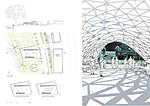Archifest Pavilion 2012
Archifest 2012 offers a unique opportunity to engage citizens and professionals to
jointly debate and rethink the foundations of good city design in Singapore. We
propose to accommodate such an important event in a multi-functional structure
that creates an open, elegant platform for presentation, debate, assembly
and exchange.
Our intervention is concentrated on a single axis centered upon the existing Art
Café terrace in the old dressing house, taking advantage of the lawn in front of it
to form a viewing slope for events. The site plan creates a charged central space,
which generates spillover activities to the adjacent green areas that contain
movable chairs and tables, arranged by visitors themselves. The wooden pavilion
deck creates a circulation loop along the existing path network to welcome
visitors from both directions to participate in its events and sit on its ledges. The
geometry of the canopy is carefully configured to generate a scenic approach, to
block the setting sun during evening lectures and to attract the descending breeze
from the hills. During the day, the canopy shelters exhibitions and facilitates
meetings for bike tours and gatherings. At night, it transforms into a lecture or
screening space. On four weekends, it becomes a temporary Farmer’s Market,
where small-scale urban farmers from all over the island can introduce and sell
their produce, 100% grown in Singapore. Instead of planting an urban farm for a
month, we provide a face for the existing farms of Singapore.
The lightweight canopy is shaped to work purely in compression, allowing
the structure to be assembled from triangular plywood modules like a masonry
vault. The force distribution in the structure is manifested in its triangulation—
triangles densify where forces increase and diffuse where forces decrease. We
use wood as a key renewable material, combined with off-the-shelf steel fixtures,
to make the structure environmentally harmless and functionally reusable after the
festival. Despite the simplicity of the standardized plywood boards and steel
hinges, complex visual variety is generated through parametric design, which also
reduces the documentation, fabrication and assembly time of the project to
merely a few weeks. The canopy is covered with recycled PVC banners sourced
from existing outdoor advertisement boards around Singapore. Different sized
banners are stitched together to form continuous layers that are fixed onto
the simple conical surface of the underlying plywood structure. Variety in the
content and coloration of the banners showcases a collage of recent temporary
events and happenings in Singapore, which Archifest, too, becomes part of.
ARUP (Russel Cole)
Café terrace in the old dressing house, taking advantage of the lawn in front of it
to form a viewing slope for events. The site plan creates a charged central space,
which generates spillover activities to the adjacent green areas that contain
movable chairs and tables, arranged by visitors themselves. The wooden pavilion
deck creates a circulation loop along the existing path network to welcome
visitors from both directions to participate in its events and sit on its ledges. The
geometry of the canopy is carefully configured to generate a scenic approach, to
block the setting sun during evening lectures and to attract the descending breeze
from the hills. During the day, the canopy shelters exhibitions and facilitates
meetings for bike tours and gatherings. At night, it transforms into a lecture or
screening space. On four weekends, it becomes a temporary Farmer’s Market,
where small-scale urban farmers from all over the island can introduce and sell
their produce, 100% grown in Singapore. Instead of planting an urban farm for a
month, we provide a face for the existing farms of Singapore.
The lightweight canopy is shaped to work purely in compression, allowing
the structure to be assembled from triangular plywood modules like a masonry
vault. The force distribution in the structure is manifested in its triangulation—
triangles densify where forces increase and diffuse where forces decrease. We
use wood as a key renewable material, combined with off-the-shelf steel fixtures,
to make the structure environmentally harmless and functionally reusable after the
festival. Despite the simplicity of the standardized plywood boards and steel
hinges, complex visual variety is generated through parametric design, which also
reduces the documentation, fabrication and assembly time of the project to
merely a few weeks. The canopy is covered with recycled PVC banners sourced
from existing outdoor advertisement boards around Singapore. Different sized
banners are stitched together to form continuous layers that are fixed onto
the simple conical surface of the underlying plywood structure. Variety in the
content and coloration of the banners showcases a collage of recent temporary
events and happenings in Singapore, which Archifest, too, becomes part of.
Credits
City Form Lab (Andres Sevtsuk, Raul Kalvo, Farre Nixon.)ARUP (Russel Cole)
